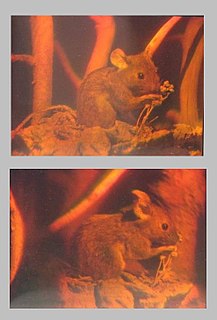 W
WHolography is the science and practice of making holograms. A hologram, also known as a holograph, is a real world recording of an interference pattern which uses diffraction to reproduce a 3D light field, resulting in an image which still has the depth, parallax, and other properties of the original scene. A hologram is a photographic recording of a light field, rather than an image formed by a lens. The holographic medium, for example the object produced by a holographic process is usually unintelligible when viewed under diffuse ambient light. It is an encoding of the light field as an interference pattern of variations in the opacity, density, or surface profile of the photographic medium. When suitably lit, the interference pattern diffracts the light into an accurate reproduction of the original light field, and the objects that were in it exhibit visual depth cues such as parallax and perspective that change realistically with the different angles of viewing. That is, the view of the image from different angles represents the subject viewed from similar angles. In this sense, holograms do not have just the illusion of depth but are truly three-dimensional images.
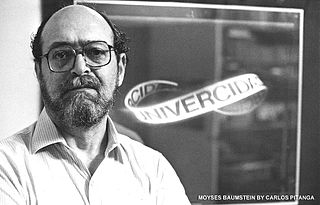 W
WMoysés Baumstein was a Brazilian artist. Baumstein worked in many fields: from literary creation to painting, from film making to holography. He was driven by singular curiosity and diligence and typified as a "Renaissance Man" joining science with art throughout his accomplishments.
 W
WStephen Anthony Benton was the E. Rudge ('48) and Nancy Allen Professor of Media & Sciences, and the Director for Center for Advanced Visual Studies (CAVS) at Massachusetts Institute of Technology. He was the inventor of the rainbow hologram and a pioneer in medical imaging and fine arts holography. Benton held 14 patents in optical physics and photography, and taught media arts and sciences at MIT.
 W
WA checkweigher is an automatic or manual machine for checking the weight of packaged commodities. It is normally found at the offgoing end of a production process and is used to ensure that the weight of a pack of the commodity is within specified limits. Any packs that are outside the tolerance are taken out of line automatically.
 W
WDigital planar holography (DPH) is a method for designing and fabricating miniature components for integrated optics. It was invented by Vladimir Yankov and first published in 2003. The essence of the DPH technology is embedding computer designed digital holograms inside a planar waveguide. Light propagates through the plane of the hologram instead of perpendicularly, allowing for a long interaction path. Benefits of a long interaction path have long been used by volume or thick holograms. Planar configuration of the hologram provider for easier access to the embedded diagram aiding in its manufacture.
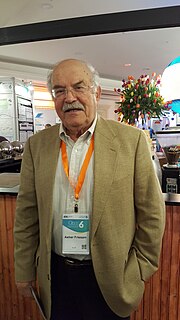 W
WAsher A. Friesem is a professor at the Weizmann Institute of Science in Israel.
 W
WHaptic technology, also known as kinaesthetic communication or 3D touch, refers to any technology that can create an experience of touch by applying forces, vibrations, or motions to the user. These technologies can be used to create virtual objects in a computer simulation, to control virtual objects, and to enhance remote control of machines and devices (telerobotics). Haptic devices may incorporate tactile sensors that measure forces exerted by the user on the interface. The word haptic, from the Greek: ἁπτικός (haptikos), means "tactile, pertaining to the sense of touch". Simple haptic devices are common in the form of game controllers, joysticks, and steering wheels.
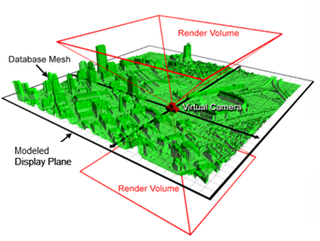 W
WA hogel is a part of a light-field hologram, in particular a computer-generated one. It is considered a small holographic optical element or HOE and that its total effect to that of a standard hologram only that the resolution is lower and it involves a pixelated structure. An array of these elements form the complete image of a holographic recording, which is typically displayed in 3D free-viewing device.
 W
WThe Hogel processing unit (HPU) is a highly parallel homogeneous computation device dedicated to rendering hogels for a holographic light-field display and encompasses the 3D scene conversion into hogels, the 2D post processing filters on hogels for spatial and color corrections and framebuffer management tasks. Hogels are similar to a sub-aperture image in a plenoptic radiance image, in that a hogel represents both the direction and intensity of light within a frustum from a given point on the light-field display plane. The resulting projected light-field is full parallax, allowing the viewer a perspective correct visualization within the light-field display view volume.
 W
WThe holographic principle is a tenet of string theories and a supposed property of quantum gravity that states that the description of a volume of space can be thought of as encoded on a lower-dimensional boundary to the region—such as a light-like boundary like a gravitational horizon. First proposed by Gerard 't Hooft, it was given a precise string-theory interpretation by Leonard Susskind, who combined his ideas with previous ones of 't Hooft and Charles Thorn. As pointed out by Raphael Bousso, Thorn observed in 1978 that string theory admits a lower-dimensional description in which gravity emerges from it in what would now be called a holographic way. The prime example of holography is the AdS/CFT correspondence.
 W
WHolographic Studios, located in the borough of Manhattan in New York City, is the world's oldest gallery of holography. It was founded in 1979 by Jason Sapan, one of the pioneers of holography. The storefront level gallery features the world's largest collection of motion image integral holograms. On display in the gallery are a variety of different types of holographic images, including a collection of celebrity hologram portraits. There are also cylindrical 360° floating images, multiple image holograms that change as you walk by, and computer generated holograms as well as a selection of novelty hologram items and stickers. Directly below the gallery is the laser laboratory where holograms are created. Holographic Studios creates custom holograms, holographic portraits, offers classes, and operates tours.
 W
WDieter Jung is a German artist working in the field of holography, painting and installation art. He lives and works in Berlin.
 W
WA kinebar is a gold bar which contains a hologram to protect its authenticity. Kinebars use a hologram called a "kinegram", a diffractive optical variable image device which is embossed into the gold substrate. "Kinegram" is a trademark of OVD Kinegram AG (Switzerland). The hologram is intended both as a high-security feature and for visual appeal.
 W
WEric Leiser is an American, filmmaker, animator and holographer.
 W
WThe MIT Museum, founded in 1971, is located at the Massachusetts Institute of Technology in Cambridge, Massachusetts. It hosts collections of holography, technology-related artworks, artificial intelligence, architecture, robotics, maritime history, and the history of MIT. Its holography collection of 1800 pieces is the largest in the world, though not all of it is exhibited. As of 2019, holographic art, and works by the kinetic artist Arthur Ganson are the two largest long-running displays. There is a regular program of temporary special exhibitions, often on the intersections of art and technology.
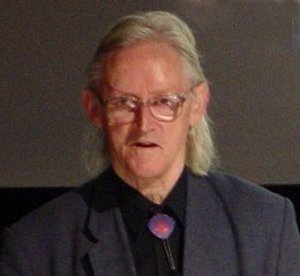 W
WNicholas (Nick) John Phillips was an English physicist, notable for the development of photochemical processing techniques for the colour hologram. Holograms typically used to have low signal-to-noise ratios, and Phillips is credited as the pioneer of silver halide holographic processing techniques for producing high-quality reflection holograms.
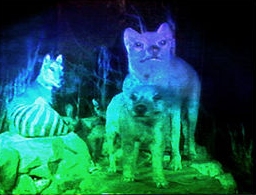 W
WThe rainbow or Benton hologram is a type of hologram invented in 1968 by Dr. Stephen A. Benton at Polaroid Corporation. Rainbow holograms are designed to be viewed under white light illumination, rather than laser light which was required before this. The rainbow holography recording process uses a horizontal slit to eliminate vertical parallax in the output image, greatly reducing spectral blur while preserving three-dimensionality for most observers. A viewer moving up or down in front of a rainbow hologram sees changing spectral colors rather than different vertical perspectives. Because perspective effects are reproduced along one axis only, the subject will appear variously stretched or squashed when the hologram is not viewed at an optimum distance; this distortion may go unnoticed when there is not much depth, but can be severe when the distance of the subject from the plane of the hologram is very substantial. Stereopsis and horizontal motion parallax, two relatively powerful cues to depth, are preserved.
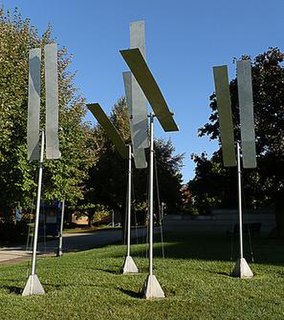 W
WRainbow Machine is a public art work by American artist Joseph Burlini, formerly located on the campus of Marquette University in downtown Milwaukee, Wisconsin.
 W
WScanning near-field ultrasound holography (SNFUH) is a method for performing nondestructive nano-scale high-resolution imaging of buried and embedded structures. SNFUH is critical for analysis of materials, structures and phenomena as they continue to shrink at the micro/nano scale. SNFUH is a type of scanning probe microscopy (SPM) technique that provides depth information as well as spatial resolution at the 10 to 100 nm scale.
 W
WSecurity holograms are labels with a hologram printed onto it for sale security reasons. Holograms on security labels are very difficult to forge because they are replicated from a master hologram which requires expensive, specialized and technologically advanced equipment. They are used widely in several banknotes around the world, in particular those that are of high denominations. They are also used in passports, credit and bank cards as well as quality products. Herman Lopata, the President of the New York-based Automatic Toll Systems, Inc., received a patent in 1987 for the credit card security hologram as part of his early work on high speed highway toll collection—the predecessor of the modern EZ Pass type equipment.
 W
WLeonard Susskind is an American physicist, who is a professor of theoretical physics at Stanford University, and founding director of the Stanford Institute for Theoretical Physics. His research interests include string theory, quantum field theory, quantum statistical mechanics and quantum cosmology. He is a member of the US National Academy of Sciences, and the American Academy of Arts and Sciences, an associate member of the faculty of Canada's Perimeter Institute for Theoretical Physics, and a distinguished professor of the Korea Institute for Advanced Study.